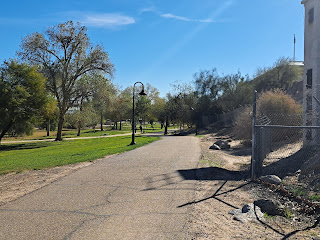Trail: Victoria Mine Trail
Hike Location: Organ Pipe Cactus National Monument
Geographic Location: south of Ajo, AZ (31.93980, -112.81183)
Length: 4.4 miles
Difficulty: 5/10 (Moderate)
Date Hiked: February 2024
Overview: An out-and-back through cactus-filled washes to the abandoned Victoria silver mine.
Park Information: https://www.nps.gov/orpi/index.htm
Hike Route Map: https://www.mappedometer.com/?maproute=956519
Photo Highlight:
At the south end of the Twin Peaks Campground, a small brown sign marks the trailhead for the Victoria Mine Trail. Immediately cacti, creosote, and other desert shrubs surround you in all directions, and the stark Sonoyta Mountains can be seen in the distance to the south. The dirt/gravel trail is unmarked, but the path on the ground is clear.
The trail heads south before curving right to head west. At 0.2 miles, you dip to pass through the first of 5 washes. These washes are dry most of the year, but each one requires a short steep descent to enter followed by a short steep climb to leave. Some of these wash entrance or exit areas have stone steps to make the grade easier to handle. The total elevation gain on this hike is just over 300 feet, but you will gain that 300 feet 30 to 50 feet at a time. A few larger trees grow in the washes, and 3 well-placed benches in 3 different washes take full advantage of the limited shade from these trees.
Near 0.3 miles, you enter the Organ Pipe Cactus Wilderness. No signs mark the wilderness boundary, and trail conditions do not change. At 1.2 miles, you reach the highest point on this hike after passing through the 3rd wash. 1.8 miles into the hike, you reach the west end of the Victoria Mine Trail, where you intersect what looks like an old dirt road. As directed by a sign, turn left to begin hiking south on the old road and continue heading for Victoria Mine.
Passing through one final wash and navigating a slightly eroded area brings you to the old Victoria Mine at 2.2 miles. Of unknown founding, this silver mine was active before 1880, and over the next 30 years $120,000 of silver ore would be extracted from this site. Today the stone ruins of the mine store capture your attention, and several nearby shafts have been capped to prevent entry. Entering an old mine shaft is a stupid proposition under any circumstances. After exploring the mine area, retrace your steps across the desert to the campground to complete the hike.
Hike Location: Organ Pipe Cactus National Monument
Geographic Location: south of Ajo, AZ (31.93980, -112.81183)
Length: 4.4 miles
Difficulty: 5/10 (Moderate)
Date Hiked: February 2024
Overview: An out-and-back through cactus-filled washes to the abandoned Victoria silver mine.
Park Information: https://www.nps.gov/orpi/index.htm
Hike Route Map: https://www.mappedometer.com/?maproute=956519
Photo Highlight:
Hike Video: (coming March 7, 2025)
Directions to the trailhead: From Ajo, drive SR 85 south 33 miles to the signed entrance for Organ Pipe Cactus National Monument on the right. Turn right to enter the monument, pay the entrance fee, then follow signs for the Twin Peaks Campground. The trailhead for the Victoria Mine Trail is located at the far (south) end of this campground; a small parking lot that holds 4 cars accommodates non-campers at the trailhead.
The hike: Located in extreme southern Arizona flush against the Mexican border, Organ Pipe Cactus National Monument protects 330,688 acres of classic rugged Sonoran desert land. The monument was established in 1937 when the Arizona state legislature donated the land to the federal government mainly for the purpose of getting more federal money to improve the area's roads. The tactic worked: SR 85 is one of the few good roads in this part of Arizona.
In 1976 the monument was declared an UNESCO Biosphere Reserve due to the large number of cacti and other desert flora that live here. In fact, many people believe the organ pipe cactus grows wild nowhere else in the United States. Despite the amazing flora, this monument also has a darker side: the large amount of illegal activity related to its location along the border. From 2003-2014 a majority of the park was closed because illegal activity made the area unsafe for hikers and tourists, but improved border security has allowed the park to reopen. I saw no illegal activity when I came here, and I never felt threatened or unsafe.
The monument contains a large but sun-drenched developed campground, a Visitor Center with many interesting exhibits, and an extensive trail system that is a hiker's paradise during the cooler months. Many hiking routes are possible, and the route described here takes you on a fairly flat journey across the desert to the abandoned Victoria Silver Mine. While the old mine is interesting, I actually found the desert scenery you have to hike through to get to the old mine to be this hike's best feature. This hike is long enough to give you a real sense of being out in the desert but does not feature any steep grades or rough terrain. That said, do not underestimate the desert sun at this low latitude. I went through plenty of water when I hiked here on a sunny mid-February afternoon with temperatures in the mid 80's, but I had a great hike worthy of being my 1000th blog hike.
 |
| Trailhead at Twin Peaks Campground |
 |
| Hiking through the saguaro cacti |
 |
| Climbing out of a wash |
 |
| Victoria mine store ruins |
 |
| Old mine shaft |





































